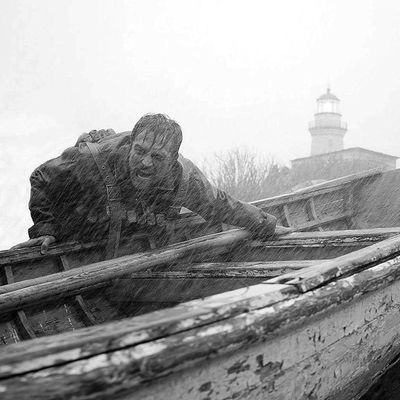
The moment the tension really breaks open in Robert Eggers’s black-and-white thriller The Lighthouse is when Robert Pattinson pulverizes a seagull with an almost cartoonish level of rage. The disruptive bird has been stalking his 19th-century wickie character for days, its every squawk driving him closer and closer to insanity. So he grabs the gull and beats its body against a cistern until it resembles a bloody rag in his hand. Wet feathers wack against stone. Bones are liquified. Blood splatters as the man just keeps swinging and swinging. It looks gruesome, but it sounds even worse.
The Lighthouse is many things. It’s a workplace comedy. It’s a male-bonding drama. At a few points, it’s even an old-timey Raymond Harryhausen–style creature epic. To achieve the cinematic potpourri, Eggers — well known for his meticulous work on the heavily researched, painstakingly art-directed period horror film The Witch — required a soundscape so attentive to detail that every creaking board and involuntary bodily function would need to add to the story’s overall sense of unease. “He’s incredibly specific about verisimilitude from his historical research,” supervising sound editor Damian Volpe tells Vulture. “So we had quite a bit of sound that got sent back for a take two — sometimes to take three or four or more.”
“Absolutely,” Foley editor Filipe Messeder adds. “That was a never-ending process.”
Indeed, in telling the surreal story of Ephraim (Pattinson) and his sole lighthouse-keeping colleague, Thomas (played by Willem Dafoe), Eggers required his crew to employ a coterie of specific noises to mimic things both violent (the bludgeoning to death of a bird) and undeniably comedic (an old man farting up a storm). Taking place on a cursed island in the American Northeast, the 2019 film recently earned cinematographer Jarin Blaschke an Oscar nomination for his own diligent work, but we feel its sonic feats of strength are worthy of recognition, too. In addition to Volpe and Messeder, Vulture spoke with Foley artists Andy Malcolm and Goro Koyama to get the backstory on the most vivid reverberations in The Lighthouse — including who’s behind those unforgettable farts.
The Flatulence
Throughout The Lighthouse, Willem Dafoe’s character is defined by a specific sound signature, comprised of his incredible salty sea-dog voice, the arhythmic beating of his limping walk, and, of course, the farting. Thomas Wake is like your least restrained grandfather, knocking around the house with his cane and no regard for whom he gasses. He terrorizes the much younger Ephraim in their sleeping quarters, the hallways, the lighthouse dining room, with his “goddamn farts!”
Volpe and Messeder have vowed never to disclose how exactly they imagined the sounds of Wake’s flatulence. “We’ll [bring] one secret to our graves, and it’s going to be where the flatulence come from,” says Volpe. But both men admitted that their sounds of passing gas did not originate in a sound library, meaning they were created practically. Call it “bespoke flatulence,” they agreed. But people who worked on the film have their own theories as to how the sounds came to be, including Dafoe. “Dafoe was very cagey about this at the festivals, because he actually doesn’t know,” Volpe says. “He claims that they were his actual farts.”
“The assistant picture editor, Katrina [Pastore], swears that it’s her making the sounds with her hands in the edit room. I’m not gonna say whether she’s right or not …” Volpe adds. “It’s like the mystery of the lighthouse. Really it’s that important. I will say on record that I think I’m the only one who knows where the flatulence comes from.”
More than just a very specific character detail, though, Volpe says the wind breaking served an important narrative purpose in a film that circles around lurid mermaid myths and intense nautical superstition. “There was a very specific direction from Rob Eggers of things that we wanted to achieve from the beginning of the film. He definitely wanted it to feel that there was a kind of a dread, but he also said it should feel almost pretentious, so that the audience is expecting a certain kind of movie until we get to the fart,” he says. “The first part happens, then your brain gets to go, ‘Woo! I can actually laugh.’”
The Seagull Slaughter
Eggers’s tonal cacophony comes to a screaming crescendo when Ephraim’s détente with a milky-eyed seagull ends in vicious conflict. Superstition tells him that harming the bird could incur the wrath of the sea, but lonely life on the island has driven him to his breaking point. “That scene is pretty horrifying to look at over and over again,” Volpe says. “I remember Eggers saying that it was the one scene he almost wished was not in black-and-white, because it was so graphic with the blood spraying on the cistern. With the sounds he wanted to capture the visceral nature of the bird being just turned into jelly as he smashes it.”
As to how that bone-liquifying noise was created, Foley artist Goro Koyama says, “With the seagull whacking, we recorded a bunch of different types of impacts on multiple tracks — a rolled-up phone book, leather gloves, a suede jacket, feather dusters, and a raw chicken. Then, we took those tracks and put them together using an editing tool in such a way so the sound would gradually shift from meaty, firm thuds to limp, feathery, goopy whacks as the poor bird turned into a lifeless lump.” Toward the end, you have a kind of “wet rag hitting stone” sound, says Messeder. “You just kind of lose all life to the bird, and I think that really helped selling the fact of how brutal it was.”
The Wretched Island
Outside of the farting and the avian murder, the island upon which The Lighthouse takes place is a terrible-sounding place in and of itself. The wind constantly whips. Nothing ever really stops dripping. That damn foghorn just keeps blaring. “Robert really wanted to make sure from the get-go that we set up a tone for the misery of [Ephraim and Thomas’s] existence — alone, scraped raw by the cold and the wind to really make you feel how hard life that would have been,” says Volpe. The director wanted his movie to have a monotonous kind of heartbeat running through it, so Volpe made recordings of waves hitting a cliffside to really capture the thump thump of the roiling waters against the island. “The interval of the waves becomes kind of naturally a pulse or a breath.”
That sonic rhythm governed the clocks hanging on the walls and the machinery moving in the bowels of the lighthouse, which was made in part by Volpe’s wife, who helped him drag chunks of metal across their basement floor during a late-night recording session. For his part, Koyama performed the sounds of the lighthouse’s grating gears while tucked into tight corners, closets, and stairwells, or surrounded by boards and boxes to make sure the acoustics were appropriately claustrophobic. (When you hear drinks being poured over dinner in the film, that’s Koyama mimicking the sounds of liquid underneath a table.)
The wickies’ personal lodgings are perhaps the most cursed location, filled with noises Messeder describes as “evil,” thwarting the human characters at every turn. “I really wanted to make everything just protest from being very helpful to these characters,” explains Messeder. “Each one of these environments just sounds like it doesn’t really want to be used. These characters are kind of unwelcomed there.” Fortunately, Volpe has an apartment in Brooklyn that was built around the same period in which the film takes place, so he and Messeder used the place as a “live space,” setting up a bunch of bottles and glasses and plates on various surfaces to recreate the “boomy environment.” Volpe says they also did body falls against his floor and “put on our hobnail boots and jumped up and down really hard.”
When asked how the two of them created the sounds for the conclusive fight scene between the younger and elder lighthouse keeps, the answer went like this:
Volpe: “We just got drunk and punched the hell out of each other, right?”
Messeder: “Oh my God. Yeah. We were very sore at the end of this.”
Volpe: “We made some thieves oil with turpentine and honey and just like closed the door and beat the shit out of each other.”
Koyama and Malcolm recorded additional battle sounds by creating a pool of water, littered with floating debris, upon which they did their own body falls. Together, they created further footstep sounds, staged punches, broke furniture, smashed glass objects, all to create the splashing sounds you hear in the background of Eggers’s film. On the physical demands of creating an absolutely miserable-feeling movie, Messeder says with satisfaction, “You know, Eggers really wanted us to feel the pain. So, we brought it.”
For any other Foley artists who have a great hardest sound story to share, let us know at [email protected].


